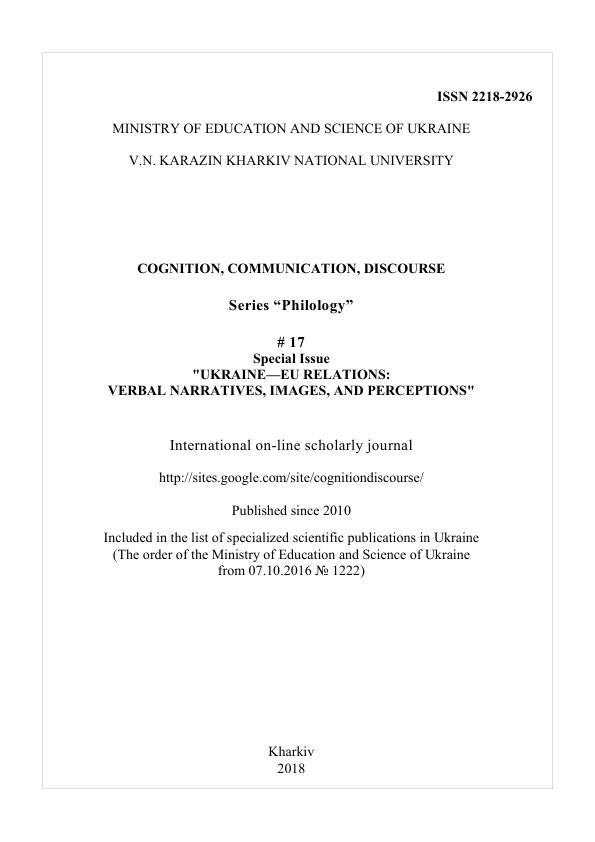Наводимо мости та сприяємо зростанню: міждисциплінарний підхід до розуміння та сприйняття Європейського Союзу
Анотація
У цій статті розглядаються концептуалізації ролей ЄС та їхня проекція на його політику Східного сусідства, зокрема на відносини з Україною. З огляду на нові акценти, які з'явилися у студіюванні нартивів та емоцій в рамках теорії міжнародних відносин (МВ) та досліджень зовнішньої політики ЄС, ми пропонуємо інноваційне міждисциплінарне поєднання теорії ролей у МВ [Harnisch et al. 2011; Holsti, 1970] та теорії концептуальної метафори, розробленої в когнітивній лінгвістиці [Lakoff and Johnson 1980]. Послуговуючись інструментарієм концептуальної метафори, ми пропонуємо системний аналіз розуміння ролей ЄС (розуміння ним самого себе), а також сприйняття ЄС (його ролей) східними партнерами, супроводжуване їхніми очікуваннями. При цьому ми започатковуємо методику системного дослідження когнітивних та емотивних складників ролей, виконуваних ЄС у реалізації його зовнішньої політики. Ця методика спирається на припущення, за яким концептуальні метафори експлікують основоположні когнітивні та емотивні ознаки, якими наділені виконувані актантами ролі. Емпіричною базою дослідження є Глобальна стратегія ЄС (червень 2016) та офіційний меморандум саміту Східного партнерства (листопад 2017), а також 12 інтерв'ю з посадовцями ЄС, задіяними у розбудові відносин між ЄС та Україною.
Завантаження
Посилання
Aggestam, L. (2006). Role Theory and European Foreign Policy: A Framework for Analysis. In Elgström, O. and Smith, M. (eds) The European Union’s Roles in International Politics. Concepts and Analysis. London and New York: Routledge.
Bengtsson, R., & Elgström, O. (2012). Conflicting Role Conceptions? The European Union in Global Politics’. Foreign Policy Analysis, 8 (1), 93-108.
Chaban, N., Kelly, S. (2017). Tracing the evolution of EU images using a case-study of Australia and New Zealand. Journal of Common Market Studies, 55 (4), 691–708.
Council of the European Union (2017). Joint Declaration of the Eastern Partnership Summit (Brussels, 24 November). Available from http://www.consilium.europa.eu/media/31758/final-statement-st14821en17.pdf
Chilton, P. A. (1996). Security metaphors. Cold War discourse from containment to common house. New York: Peter Lang.
Davis Cross, M., & Karolewski, I. (2017). What Type of Power has the EU Exercised in the Ukraine–Russia Crisis? A Framework of Analysis. Journal of Common Market Studies, 55 (1), 3–19.
Drulák, P. (2004). Metaphors Europe lives by: language and institutional change of the European Union, EUI Working Paper SPS 2004/15, Florence: European University Institute. Available from http://hdl.handle.net/1814/2632.
Elgström, O., & Smith, M. (eds) (2006). The European Union’s roles in international politics. London: Routledge.
EU Global Strategy (EUGS) (2016). Available from http://europa.eu/globalstrategy/en/global-strategy-foreign-and-security-policy-european-union
Flanik, W. (2011). “Bringing FPA back home”: cognition, constructivism, and conceptual metaphor. Foreign Policy Analysis, 7 (4), 423-446.
Harnisch, S. (2011). Role Theory: Operationalization of Key Concepts. In Harnisch, S. Frank, C. and Maull, H.W. (eds.). Role Theory in International Relations. London and New York: Routledge, 7-15.
Harnisch, S., Frank, C., & Maull, H.W. (eds) (2011). Role Theory in International Relations. London and New York: Routledge.
Holland, M., & Chaban, N. (2011). The EU as an agent for democracy: images of the EU in the Pacific media “mirror”. Journal of European Integration, 33 (3), 285-330.
Holsti, K. (1970). National role conceptions in the study of foreign policy. International Studies Quarterly, 14 (3), 233-309.
Howorth, J. (2017). Stability on the Borders: The Ukraine Crisis and the EU’s Constrained Policy towards the Eastern Neighbourhood. Journal of Common Market Studies, 55 (1), 121–136.
Jansen, S. C., & Sabo, D. (1994). The sport-war metaphor: hegemonic masculinity, the Persian-Gulf war, and the new world order’ Sociology of Sport Journal, 11 (1), 1-17.
Klose, S. (2018). Theorizing the EU's Actorness: Towards an Interactionist Role Theory Framework. Journal of Common Market Studies, First published: 30 March 2018, DOI: 10.1111/jcms.12725.
Lakoff, G., & Johnson, M. (1980). Metaphors we live by. Chicago: University of Chicago Press.
Marks, M. P. (2011). Metaphors in International Relations Theory. New York: Palgrave Macmillan.
Musolff, A. (2010). Political Imagery of Europe: a house without exit doors?’. Journal of Multilingual and Multicultural Development, 21 (3), 216-229.
Opperman, K., & Spencer, A. (2013). Thinking alike? Salience and metaphor analysis as cognitive approaches to foreign policy analysis. Foreign Policy Analysis, 9 (1), 39-56.
Orenstein, M., & Keleman, R.D. (2017). Trojan Horses in EU Foreign Policy. Journal of Common Market Studies, 55 (1), 87–102.
Rohrer, T. (1995). The metaphorical logic of (political) rape: George Bush and the new world order. Metaphor & Symbolic Activity, 10 (2), 113-131.
Thies, C., & Breuning, M. (2012), Integrating Foreign Policy Analysis and International Relations Theory through Role Theory. Foreign Policy Analysis, 8 (1), 1-4.
Автори, які публікуються у цьому журналі, погоджуються з наступними умовами:
Автори залишають за собою право на авторство своєї роботи та передають журналу право першої публікації цієї роботи на умовах ліцензії Creative Commons Attribution License (CC BY), яка дозволяє іншим особам вільно розповсюджувати опубліковану роботу з обов'язковим посиланням на авторів оригінальної роботи та першу публікацію роботи у цьому журналі.
Автори мають право укладати самостійні додаткові угоди щодо неексклюзивного розповсюдження роботи у тому вигляді, в якому вона була опублікована цим журналом (наприклад, розміщувати роботу в електронному сховищі установи або публікувати у складі монографії), за умови збереження посилання на першу публікацію роботи у цьому журналі.
Політика журналу дозволяє і заохочує розміщення авторами в мережі Інтернет (наприклад, у сховищах установ або на особистих веб-сайтах) рукопису роботи, як до подання цього рукопису до редакції, так і під час його редакційного опрацювання, оскільки це сприяє виникненню продуктивної наукової дискусії та позитивно позначається на оперативності та динаміці цитування опублікованої роботи (див. The Effect of Open Access).




